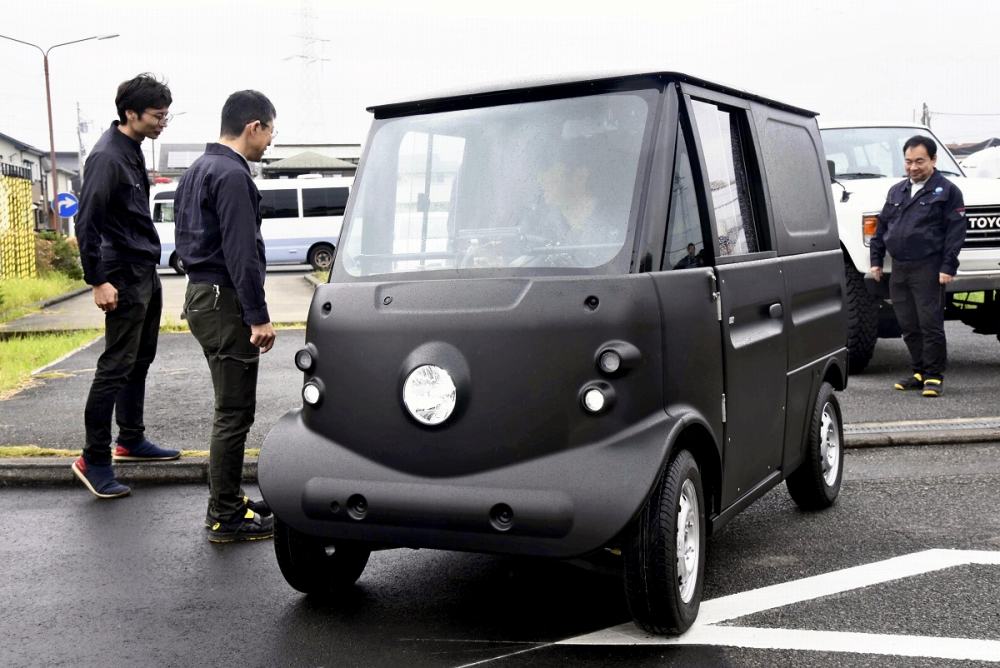ANN/THE JAPAN NEWS – Japanese startups are shifting their focus to developing ultra-compact electric vehicles (EVs).
Single-seater prototypes will be in the spotlight at the Japan Mobility show – previously the Tokyo Show – which begins on October 26 and is expected to draw about one million visitors.
The companies are aiming to emphasise the small vehicles’ potential, such as for delivery and other basic transport.
DRUMMING UP SUPPORT
In early October, a small, simply designed EV took part in a performance test at a driving school in Chigasaki, Kanagawa Prefecture. The vehicle, dubbed “Kurosuke”, sported a black chassis and a single front light.
The prototype car belonged to the Micro EV Technology Research Association (METAx), which is among the groups planning to display products at the Japan Mobility Show.
“We’re finally on the starting line,” said Hiroyuki Takemura, 52, who played a leading role in the vehicle’s planning, which took about two years.
Takemura and other former vehicle developers at Nissan Motor Corp have created a company to develop technology and design for EVs. METAx was established by the developers’ company in conjunction with three parts manufacturers.

Kurosuke is classified as a Class-1 motorised bicycle, or a minicar, and is smaller than a light motor vehicle. It was designed to come in just under the light motor vehicle threshold, thus allowing it to carry as much cargo as possible. To ensure its competitiveness, the development team threw out unessential elements wherever possible.
As a result, the car is not painted, nor does it have rear windows.
After establishing the operational company, the team plans to farm out production to Tonox – a car body manufacturer in the city of Hiratsuka, Kanagawa Prefecture. The developers aim to start accepting reservations for the new vehicle in 2025.
However, the team has yet to secure large-lot customers or parts suppliers. Nevertheless, Takemura remained upbeat, saying, “We hope to meet people at the Japan Mobility Show who support our efforts.”
LOWER BARRIER FOR STARTUPS
Minicars are expected to be used for short-distance deliveries – which have seen growing demand due to the spread of online commerce – and as vehicles for shopping among older people. Compared with motorbikes for deliveries, minicars are more stable and can easily carry more goods and supplies.
Minicar manufacturers can enter the market without having to clear high hurdles, as minicars are not subject to “type designation”, a system used in connection with the mass-production of vehicles. Apart from major automakers, it has been traditionally difficult for firms to obtain such authorisation.
Furthermore, minicars are not subject to periodic inspections, meaning owners have lower maintenance costs than those associated with light motor vehicles. Advantages such as these have prompted other startups to start developing minicars. KG Motors Co – founded last year in Higashi-Hiroshima, Hiroshima Prefecture – plans to exhibit an ultra-compact EV at the Japan Mobility Show.
The company’s prototype vehicle is based on an idea presented by Representative Director Kazunari Kusunoki for “cars that are more adaptable and can turn in a small space”. Kusunoki was raised in an area with many narrow streets.
The retro-styled car, inspired by a Polaroid camera, is likely to attract much attention at the show. The number of parts was reduced by making the four corners of the car similar in design.
Awareness of the car grew after the firm uploaded a video to YouTube showing the vehicle’s development process, and the car garnered the second-largest number of votes in a popularity poll conducted at the Osaka Auto Messe motor show in February.
KG Motors hopes to capitalize on exposure at the upcoming show with the aim of bringing its car to market in 2025 with a JPY1 million (about USD6,686) price tag.
Minicars must conform to strict requirements, such as having a maximum speed of 60 kilometres per hour, which has slowed their development among major makers. Currently, Toyota Auto Body Co’s Coms enjoys the largest slice of the market. To date, the company, which started selling the vehicle in 2012, has sold more than 10,000 units.
DEVELOPMENTAL CHALLENGES
“Single-seater cars have limited uses, and it’s difficult to turn a profit on them,” said Hideo Tsurumaki, 61, who participated in the development of Coms and has founded an EV-development firm. “But if minicars draw more attention and the market expands, I’d like to produce them again.”



